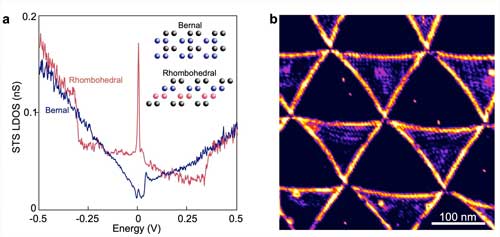| Jan 22, 2021 |
A new natural platform for realizing flat-band-based quantum phenomena and topological states
(Nanowerk News) Electrons in solids can have only certain energies, called bands. In recent years, it was shown experimentally that the range of energies allowed for electrons can be tuned by twisting two layers of graphene relative to each other.
|
|
Under appropriate conditions, the range of allowed energies is very narrow, leading to a ‘flat band’. It was demonstrated that in these flat bands, unexpected quantum phenomena such as superconductivity and magnetism arose tentatively due to the strong interactions between the electrons.
|
|
Since that work, it has been an open question as to how to make new quantum phenomena appear by engineering the allowed energies of electrons in such structures.
|
|
A paper by researchers from Columbia University, the Max Planck Institute for the Structure and Dynamics of Matter (MPSD) and RWTH Aachen University now published in Proceedings of the National Academy of Sciences USA ("Moiréless correlations in ABCA graphene") demonstrates that four-layer rhombohedral graphene is a new material for realizing flat-band-based quantum phenomena in a natural way.
|
|
Rhombohedral graphene is a material known for many years and closely related to bernal graphene, the more stable and common form of graphite. Rhombohedral graphene can be formed from bernal graphene by simply sliding the individual layers relative to each other, but this way it is unstable and can easily transform itself back to bernal graphene.
|
 |
| a. STS LDOS of Bernal and rhombohedral graphene domains in small-angle twisted double bilayer graphene. The inset shows the atomic stacking for Bernal and rhombohedral graphene. b. STS LDOS map at -20 meV showing the emergence of edge states. An external displacement field opens a gap on Bernal and rhombohedral graphene. (Image: Carmen Rubio-Verdú) (click on image to enlarge)
|
|
The researchers demonstrated a new, simple and robust method for producing large (micrometer-scale) regions of uniform rhombohedral four-layers graphene in their work, by introducing a small twist between two layers of bilayer graphene. In this new material, triangular regions of rhombohedral graphene are confined between regions of bernal graphene. The researchers then showed that the electrons in the rhombohedral graphene regions are narrowly confined in energy, creating the right conditions to observe quantum phenomena.
|
|
Moreover, the team demonstrated that the allowed energies for electrons can be tuned by applying a static electric field. When such an electric field was applied, a surprise emerged – the electrons were found to be confined in narrow regions between the rhombohedral and bernal graphene, in so-called topological edge states. Since the electric field can be turned on and off at will, this new material is an ideal programmable topological quantum material. This in turn has possible ramifications for topological quantum computing, where topologically protected edge modes might constitute qubits – the fundamental building blocks of a quantum computer.
|
|
“It is fascinating to see how competing structural and electronic interactions can coherently interact and affect the macroscopic properties of a few graphene layers,” say the MPSD authors Dante Kennes, Lede Xian and Angel Rubio. “We are currently investigating whether similar phenomena can be observed in other two-dimensional heterostructures and whether the introduced concept can be extended to thicker samples consistent of many layers in which twisting introduced novel topological three-dimensional phases.”
|
|
Further exploration of rhombohedral graphene can provide answers to certain fundamental questions, for instance regarding the importance of moiré potentials and integer fillings in generating emergent phases such as superconductivity in neighbouring regions of the phase diagram. The chiral nature of the tuneable topological edge states in rhombohedral graphene also makes it of great interest to observe gyrotropic effects and toward Floquet engineering.
|
|
“This work opens up new avenues to control and design phenomena in correlated and topological materials," concludes MPSD Theory director Ángel Rubio. Columbia University Professor of Physics Abhay Pasupathy and postdoctoral fellow Carmen Rubio-Verdù concur: “The topological and quantum properties we discovered came as a surprise to us, and we are excited to explore this class of materials further to see what new quantum surprises await us.”
|

